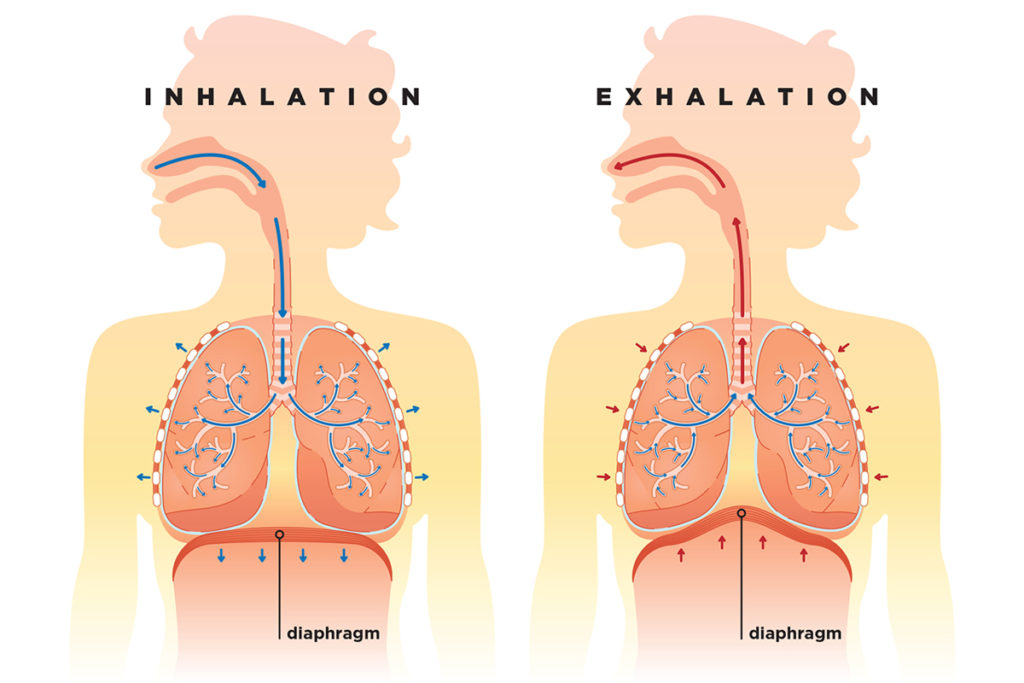Diagramming the Diaphragm
Find out more about this essential breathwork muscle.

Breathing, hiccups, abdominal thrusts, the Valsalva maneuver—these are just some of the many actions that require the steady work of the diaphragm.
This dome-shaped structure at the base of the lungs connects the thoracic cavity and the abdominal cavity. As a major respiratory muscle, the diaphragm contracts rhythmically to assist in breathing. During inhalation, it contracts and flattens to enlarge the chest cavity, allowing the lungs to expand and pull in air. During exhalation, it relaxes and returns to its full shape, pushing air back out of the lungs (Gorman 2021).
In addition to respiratory assistance, it also works with the abdominal muscles. As it contracts, it helps to increase intra-abdominal pressure. This pressure is needed for actions like expelling vomit, defecating, urinating and giving birth (Gorman 2021).
Read on to expand your knowledge:
- Roughly 1 in every 3,600 babies in the United States is born with a diaphragmatic hernia, which occurs when there is a hole in the diaphragm that allows abdominal organs to move up into the chest, preventing the baby’s lungs from developing completely and thus causing breathing difficulties (CDC 2020).
- Hiccups occur when the diaphragm contracts involuntarily due to an irritation, like eating too quickly or drinking carbonated beverages. When air is inhaled as the diaphragm is contracting, the space between the vocal cords at the back of the throat closes abruptly, producing the sound of a hiccup (Taylor 2019).
- People can use diaphragmatic breathing by fully engaging the stomach, abdominal muscles and diaphragm to take deeper breaths. This can provide several health benefits, including strengthening the diaphragm, reducing oxygen demand, improving core stability, lowering heart rate and blood pressure, and increasing relaxation (Johnson 2020).
- Balanced nutrition is key to maintaining the health of the diaphragm, since malnutrition has been shown to reduce respiratory muscle mass and contractibility (Dureuil & Matuszczak 1998).
- During weightlifting, the diaphragm is used in the well-known Valsava maneuver, which assists the muscles of the anterior abdominal wall to raise the intra-abdominal pressure. The maneuver is also used to augment and classify heart murmurs (Bains, Kashyap & Lappin 2021).
See also: A Strong Diaphragm for a Strong Core
References
Bains, K.N.S., Kashyap, S., & Lappin, S.L. 2021. Anatomy, thorax, diaphragm. StatPearls. Accessed Sept. 7, 2021: ncbi.nlm.nih.gov/books/NBK519558.
CDC (Centers for Disease Control and Prevention). 2020. Facts about diaphragmatic hernia. Accessed Sept. 7, 2021: cdc.gov/ncbddd/birthdefects/diaphragmatichernia.html.
Dureuil, B., & Matuszczak, Y. 1998. Alteration in nutritional status and diaphragm muscle function. Reproduction, Nutrition, Development, 38, 175–80.
Gorman, N. 2021. Diaphragm. Kenhub. Accessed Sept. 7, 2021: kenhub.com/en/library/anatomy/diaphragm.
Johnson, J. 2020. What to know about diaphragmatic breathing. Medical News Today. Accessed Sept. 7, 2021: medicalnewstoday.com/articles/diaphragmatic-breathing#what-is-it.
Taylor, T. 2019. Diaphragm. Innerbody Research. Accessed Sept. 7, 2021: innerbody.com/image/musc06.html.
Sarah Kolvas
Sarah Kolvas is the content manager for IDEA.






